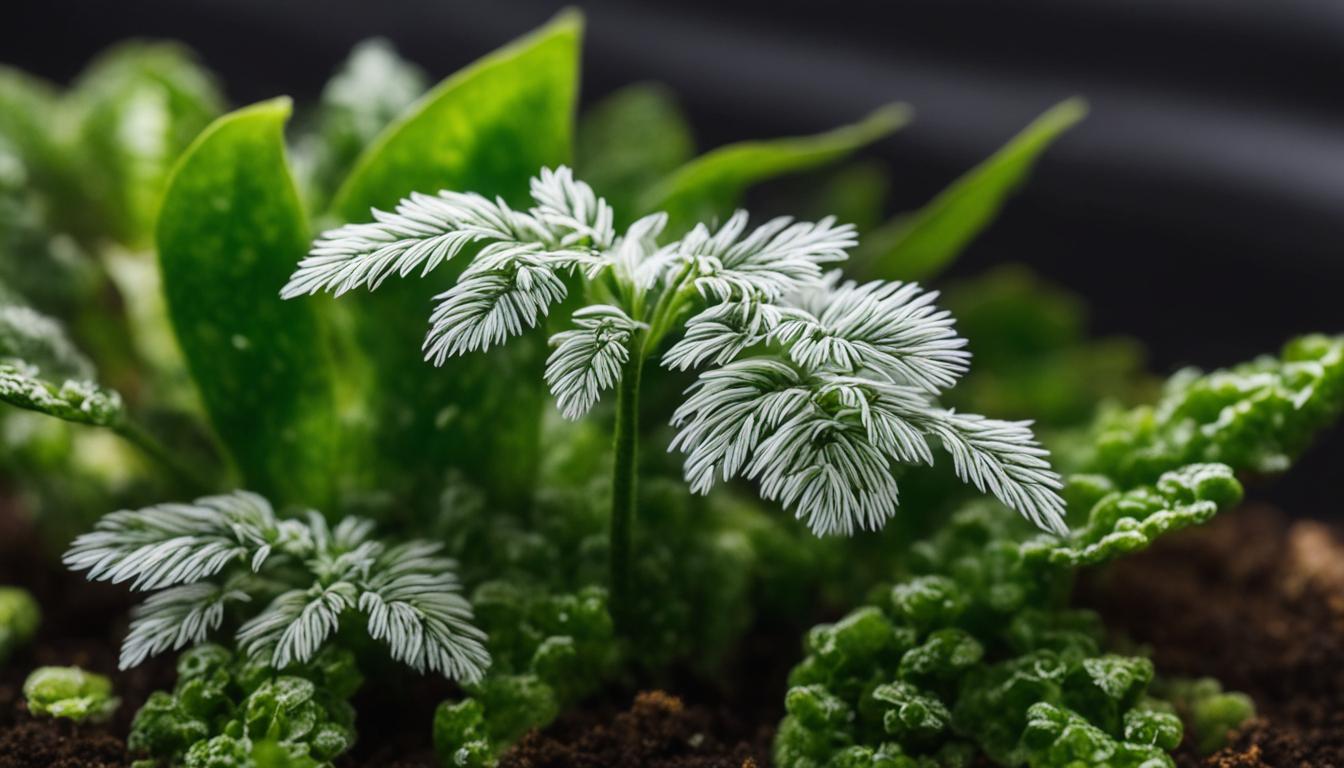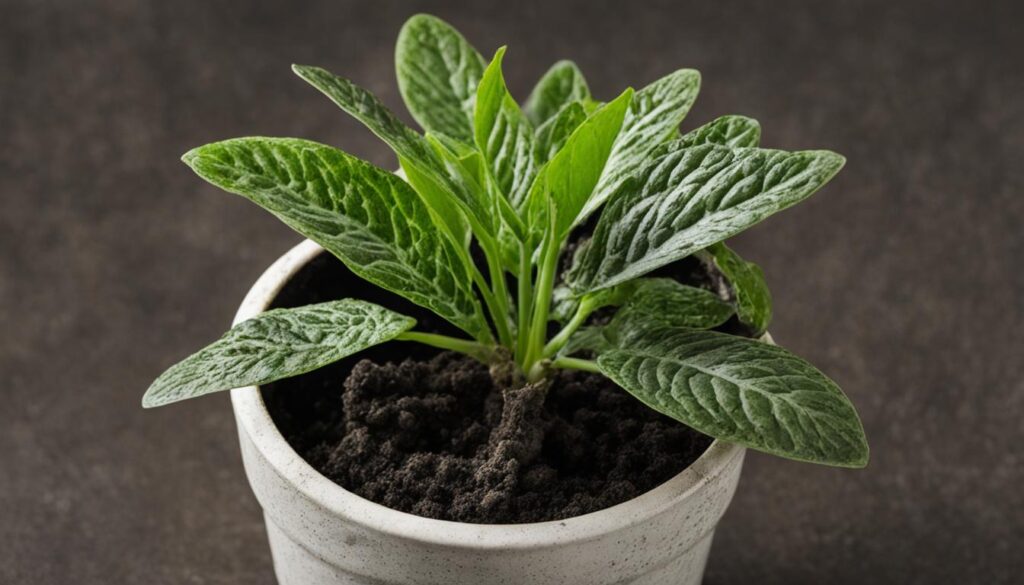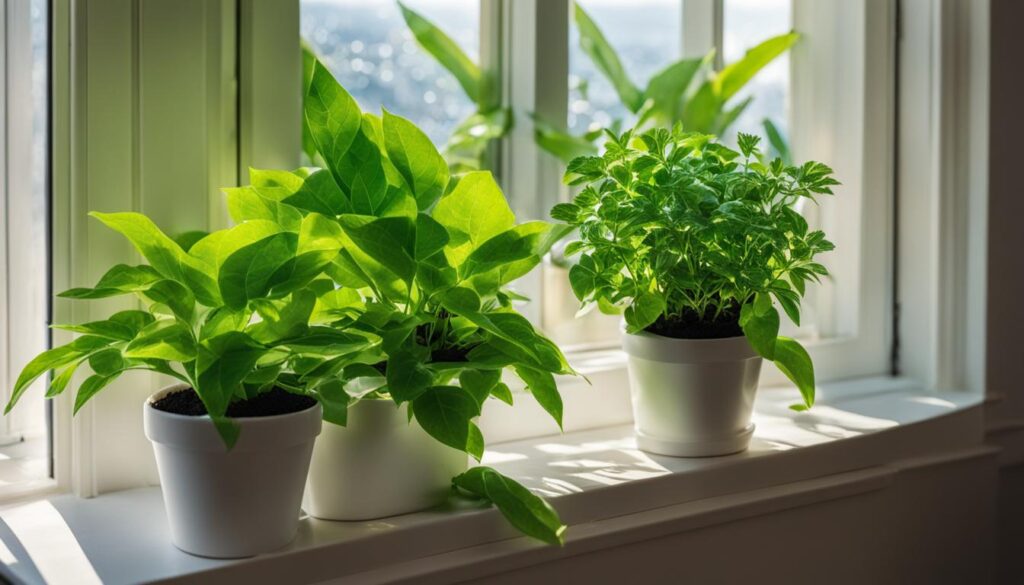
Banish Mold on Houseplant Soil Effectively
As a houseplant owner, one of the most common issues you may face is mold growth on the soil. This can hinder the growth of your plants and also pose health hazards to you and your family. In this article, we will guide you on how to effectively eliminate mold on houseplant soil and provide you with tips on how to prevent future growth.
Key Takeaways:
- Regular soil maintenance is key to preventing mold growth on houseplant soil
- Proper watering practices can significantly reduce the risk of mold infestation
- DIY natural remedies can be used to eliminate mold without using harsh chemicals
- Professional mold remediation services may be required for severe mold infestations
- Preventive measures must be taken to ensure long-term mold prevention for healthy houseplants
Understanding Mold Growth on Houseplant Soil
Mold growth on houseplant soil can be a common issue, but understanding why it occurs is essential to managing and preventing future infestations. Mold thrives in moist environments, and if the soil is consistently damp, it can create the perfect conditions for mold spores to flourish. Additionally, mold can also occur due to poor ventilation or overcrowding of plants, as it increases the humidity level around the plants.
To effectively manage mold growth on houseplants, it’s crucial to take preventative steps. Regularly checking soil moisture levels and adjusting your watering schedule appropriately is a good place to start. It’s also essential to provide adequate ventilation and avoid overcrowding plants to minimize excessive humidity around the plants.
When it comes to mold control, there are both natural and chemical remedies available. Some natural options include using cinnamon, baking soda, or apple cider vinegar as a soil amendment to change the pH level and prevent mold growth. Additionally, commercial mold control products are available that can help eliminate mold in severe cases.
By understanding the reasons behind mold growth on houseplant soil and implementing preventative measures, you can effectively manage and prevent mold infestations in your home.
Signs of Mold Infestation on Houseplant Soil
If you notice any of the following signs on your houseplant soil, it is likely that you have a mold infestation:
- Visible mold: Mold on houseplant soil is often visible as a white or grayish powdery substance on the top of the soil.
- Unpleasant odor: Mold on houseplant soil emits a musty or sour smell that is unpleasant and strong.
- Yellow or discolored leaves: When mold grows on houseplant soil, it can cause the leaves to turn yellow or become discolored.
- Stunted plant growth: Mold infestations can interfere with the plant’s ability to absorb nutrients and water, resulting in stunted growth.
Identifying mold on houseplant soil early on is crucial as it allows you to take prompt action to eliminate the infestation and prevent it from spreading to other plants in your home. Take a closer look at your houseplants regularly to detect any mold growth as early as possible.
Removing Mold from Houseplant Soil
Removing mold from houseplant soil can seem like a daunting task, but with the right steps, it can be easily accomplished. The first step in removing mold is to identify the affected plants and isolate them. This can prevent the spread of mold spores to other houseplants.
The second step is to remove the top layer of soil where mold is present. This can be done using a small shovel or a spoon. Be sure to dispose of the soil immediately, as mold spores can spread through the air and cause new infestations.
The third step is to treat the remaining soil with a fungicide. There are several natural options available, including neem oil and cinnamon powder, which are effective in eliminating mold spores. Follow the instructions carefully when using these products.
Additionally, it is important to address the underlying cause of mold growth in houseplant soil. Overwatering is a common culprit, so be sure to maintain proper watering practices and avoid leaving standing water in plant saucers.
With these steps, you can successfully remove mold from your houseplant soil and prevent future infestations.
Step-by-Step Guide:
- Identify affected plants and isolate them.
- Remove top layer of mold-infested soil using a small shovel or spoon.
- Treat remaining soil with a natural fungicide such as neem oil or cinnamon powder, following instructions carefully.
- Improve soil drainage and avoid overwatering to prevent future mold growth.
Prevention Tips for Mold on Houseplant Soil
Mold prevention is key to maintaining healthy houseplants. By implementing proper watering techniques and soil maintenance practices, you can reduce the chances of mold growth on your houseplant’s soil. Here are some expert tips to help you prevent mold:
| Tip | Description |
|---|---|
| 1. | Water your plants on a regular schedule and avoid overwatering. Ensure the soil is dry before watering and avoid leaving standing water. |
| 2. | Avoid using overly dense or moisture-retentive soils. Instead, choose a well-draining and airy mix that promotes healthy root growth. |
| 3. | Clean and maintain your pots and trays regularly to eliminate any lingering mold spores or bacteria. |
| 4. | Provide adequate airflow around your plants by opening windows or using fans, as stagnant air can promote mold growth. |
| 5. | Use natural mold prevention remedies such as cinnamon, neem oil, or vinegar to treat early signs of mold growth. Avoid using harsh chemicals that can harm your plants. |
Following these prevention tips can help you maintain a mold-free environment for your houseplants. For more information on mold prevention and remediation services in Miami, Florida, contact FixMold at 305-465-6653.
Managing Mold on Houseplants: Watering Practices
Proper watering practices are crucial to preventing mold growth on houseplants. Overwatering can cause excess moisture in the soil, creating a breeding ground for mold to thrive. Underwatering, on the other hand, can cause stress to the plant, making it more susceptible to mold infestations.
When watering your houseplants, it’s essential to consider factors such as the plant’s species, size, and the environment in which it grows. Most houseplants prefer evenly moist soil, so water them only when the top inch of soil feels dry to the touch.
To water effectively, pour water slowly onto the soil, allowing it to absorb gradually. Ensure that the water reaches the deeper roots, but avoid getting water on the leaves or the plant’s stem as this can create moisture that supports mold growth. Use a watering can with a long spout or a drip tray to prevent water from splashing onto the leaves.
When possible, use filtered water or tap water that has been left in an open container for at least 24 hours. This allows chlorine and other chemicals to evaporate, making the water safer for your plants. Avoid using standing water in the saucer beneath the pot as it can create a humid environment that encourages mold growth.
In addition to proper watering practices, ensure that your plant containers have good drainage and that the soil is well-aerated to prevent excess moisture. Consider placing a layer of gravel or sand at the bottom of the pot to ensure proper drainage.
By following these watering practices, you can prevent mold growth on your houseplants and maintain a healthy environment for your plants to thrive.
Soil Maintenance: Key to Mold Prevention
Regular soil maintenance is integral to preventing mold growth on houseplant soil. The soil is a crucial component of a plant’s health and providing the right environment for your houseplants will prevent mold growth. Here are some tips for maintaining healthy soil:
- Use high-quality soil and fertilizer.
- Ensure proper drainage by adding perlite or vermiculite to the soil.
- Remove dead leaves or plants from the soil to prevent decay.
- Do not overwater your plants, and avoid letting water sit in the saucer below the pot.
Maintaining healthy soil is particularly vital for preventing mold growth. Soil that’s too wet or too dry can create an environment where mold can flourish. By regularly checking the soil moisture and addressing any issues promptly, you can keep your houseplants healthy and mold-free.
To illustrate the importance of soil maintenance, the following table compares the mold growth rates on overwatered and well-maintained soil:
| Overwatered Soil | Well-maintained Soil | |
|---|---|---|
| Mold Growth Rate | High | Low |
| Plant Health | Weak and susceptible to diseases | Strong and vibrant |
| Soil Moisture Level | Excessively wet | Optimal |
Regular soil maintenance can help you avoid mold growth on houseplant soil and promote overall plant health. By following these tips, you can create the right environment for your houseplants to thrive.

Natural Remedies for Mold on Houseplant Soil
Eliminating mold on houseplant soil doesn’t have to involve harsh chemicals that can harm your plants. Natural remedies can be just as effective without compromising your plants’ health. Here are some DIY solutions to try:
- Cinnamon: Sprinkle cinnamon on top of the soil to prevent mold growth. Cinnamon has anti-fungal properties that can eradicate mold spores.
- Baking Soda: Mix one teaspoon of baking soda with one quart of water and pour the solution on your houseplant soil every four weeks to prevent mold growth. Baking soda is a natural fungicide that can kill mold on contact.
- Hydrogen Peroxide: Mix one part hydrogen peroxide with four parts water and spray on the moldy soil. This solution can kill mold spores and prevent mold growth in the future.
- Neem Oil: Mix two tablespoons of neem oil with one gallon of water and spray it on the moldy soil. Neem oil is a natural fungicide that can help eliminate mold spores.
These natural remedies are safe and effective options for eliminating mold on houseplant soil. Give them a try and watch your plants thrive!
Professional Mold Remediation Services
In severe cases of mold infestations on houseplant soil, it may be necessary to hire professional mold remediation services. These experts have the tools and knowledge necessary to tackle even the most challenging mold issues.
Professional mold remediation services use specialized equipment, such as air scrubbers and HEPA vacuums, to remove mold spores from the air and minimize the risk of spreading. They also use safe and effective cleaning products to eliminate mold on houseplant soil, leaving your plants healthy and mold-free.
Additionally, professional services can provide advice on mold prevention and help you take steps to protect your houseplants from future infestations. By hiring a professional, you can ensure that your houseplants remain in excellent health and that any mold issues are dealt with safely and effectively.
When to Consider Professional Mold Remediation Services
If you have tried DIY mold removal methods on houseplant soil and the issue persists, it may be time to consider professional mold remediation services. Additionally, if you or anyone in your household experiences symptoms of mold exposure, such as allergies or respiratory issues, it is essential to call in a professional for safe and thorough mold removal.
Remember, the health and well-being of your family and houseplants depend on keeping mold at bay. Don’t hesitate to seek professional help when needed.
Long-Term Mold Prevention for Healthy Houseplants
Now that you’ve eliminated mold from your houseplant soil, the next step is to ensure it doesn’t return. Here are some long-term mold prevention tips for maintaining healthy houseplants:
- Proper Soil Maintenance: Regular soil maintenance is crucial for preventing mold growth on houseplants. Make sure to remove any dead leaves or stems from the soil and replace the top layer of soil every few months to discourage mold growth.
- Watering Practices: Proper watering techniques play a significant role in mold prevention. Avoid overwatering your plants, as this creates a damp environment that encourages mold growth. Instead, water your plants when the soil is dry to the touch.
- Air Circulation: Good air flow is essential for maintaining healthy houseplants and preventing mold growth. Place your plants in a well-ventilated area and consider using a fan to improve air circulation.
- Regular Cleaning: Dust and debris can accumulate on houseplant leaves, creating an ideal environment for mold to grow. Regularly dust and wipe down your plants to keep them clean and healthy.
- Natural Remedies: As we discussed in section 8, some natural remedies, like cinnamon and chamomile tea, can help prevent mold growth on houseplant soil. Consider using these natural remedies in conjunction with the above prevention tips.
By following these long-term mold prevention techniques, you can maintain healthy and vibrant houseplants while keeping mold at bay.

Conclusion
Managing mold on houseplant soil is crucial to ensure healthy and vibrant plants. By following the tips and techniques outlined in this article, you can effectively banish mold on houseplant soil, prevent future infestations, and maintain a mold-free environment for your houseplants. Remember to prioritize proper watering practices, regular soil maintenance, and seek professional help when needed.
For residents of Miami, Florida, FixMold is the go-to solution for mold assessments, prevention, and remediation. Contact us at 305-465-6653 for assistance with all your mold-related concerns.
Don’t let mold on houseplant soil take over your home. With the right tools and knowledge, you can effectively manage mold growth and maintain a healthy and beautiful indoor garden. Follow our houseplant care tips, and enjoy happy and thriving plants for years to come.
FAQ
How can I eliminate mold on houseplant soil?
To eliminate mold on houseplant soil, you can start by removing any visible mold growth with a spoon or fork. Next, allow the soil to dry out by reducing watering and increasing ventilation. You can also sprinkle cinnamon or a hydrogen peroxide solution on the soil to inhibit mold growth. Avoid overwatering and make sure the plant has proper drainage.
What should I do to manage mold on houseplants?
To manage mold on houseplants, it’s important to implement proper watering practices. Only water your plants when the top inch of soil is dry, and make sure there is sufficient drainage. Additionally, ensure your plants have adequate air circulation and avoid overcrowding them. Regularly inspect your plants for signs of mold and take appropriate action if detected.
What are the signs of mold infestation on houseplant soil?
The signs of mold infestation on houseplant soil include a fuzzy or slimy growth on the surface of the soil, a musty odor, and wilting or yellowing leaves. You may also notice mold spores floating in the air when disturbed. If you observe any of these signs, it’s important to address the issue promptly to prevent further spread.
How do I remove mold from houseplant soil?
To remove mold from houseplant soil, start by removing any infected plants from the other healthy ones. Carefully scoop out the moldy soil and dispose of it in a sealed bag. Next, replace the contaminated soil with fresh, well-draining potting mix. Avoid overwatering the plant and maintain proper ventilation to prevent future mold growth.
What are some prevention tips for mold on houseplant soil?
To prevent mold on houseplant soil, ensure your plants are in well-draining pots and use a quality potting mix. Water your plants only when the soil is dry and avoid overwatering. Provide adequate ventilation and avoid overcrowding your plants. Regularly clean the plant’s leaves to remove any dust or debris that can contribute to mold growth.




